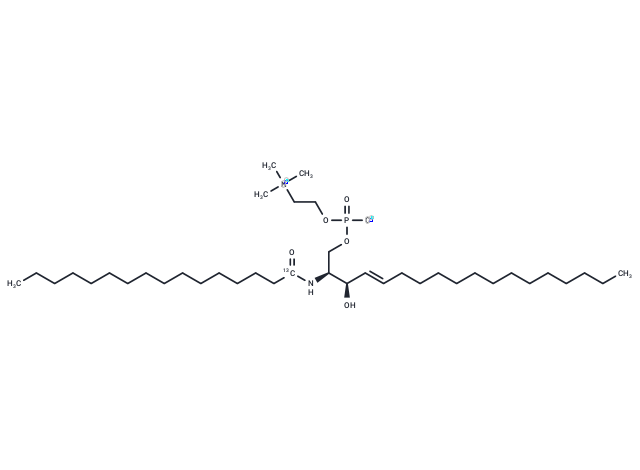- Remove All
 Your shopping cart is currently empty
Your shopping cart is currently empty
13C C16 Sphingomyelin (d18:1/16:0)
13C C16 Sphingomyelin is an isotopically enriched form of C16 sphingomyelin with carbon-13 occurring on the fatty acid portion. It is intended for use as an internal standard for the quantification of C16 sphingomyelin by GC- or LC-MS. C16 Sphingomyelin is a form of sphingomyelin containing palmitate (16:0) at the variable acylation position. It is the most common form of sphingomyelin found in eggs and is less abundant in the brain and in milk. C16 Sphingomyelin interacts with cholesterol in ordered lipid domains (lipid rafts). Sphingomyelinases remove phosphorylcholine from C16 sphingomyelin to produce C16 ceramide. While ceramides commonly induce apoptosis, ceramides with different fatty acid chain lengths might direct distinct functions and, in some cases, reduce apoptosis.

13C C16 Sphingomyelin (d18:1/16:0)
| Pack Size | Price | Availability | Quantity |
|---|---|---|---|
| 1 mg | $464 | Backorder |
Product Introduction
| Description | 13C C16 Sphingomyelin is an isotopically enriched form of C16 sphingomyelin with carbon-13 occurring on the fatty acid portion. It is intended for use as an internal standard for the quantification of C16 sphingomyelin by GC- or LC-MS. C16 Sphingomyelin is a form of sphingomyelin containing palmitate (16:0) at the variable acylation position. It is the most common form of sphingomyelin found in eggs and is less abundant in the brain and in milk. C16 Sphingomyelin interacts with cholesterol in ordered lipid domains (lipid rafts). Sphingomyelinases remove phosphorylcholine from C16 sphingomyelin to produce C16 ceramide. While ceramides commonly induce apoptosis, ceramides with different fatty acid chain lengths might direct distinct functions and, in some cases, reduce apoptosis. |
| Molecular Weight | 704.035 |
| Formula | C39H79N2O6P |
| Cas No. | 144236-99-7 |
| Storage | Powder: -20°C for 3 years | In solvent: -80°C for 1 year | Shipping with blue ice. |
| Solubility Information | Chloroform: Soluble Ethanol: Soluble Methanol: Soluble |
Calculator
In Vivo Formulation Calculator (Clear solution)
Dose Conversion
Tech Support
Keywords

Copyright © 2015-2025 TargetMol Chemicals Inc. All Rights Reserved.




